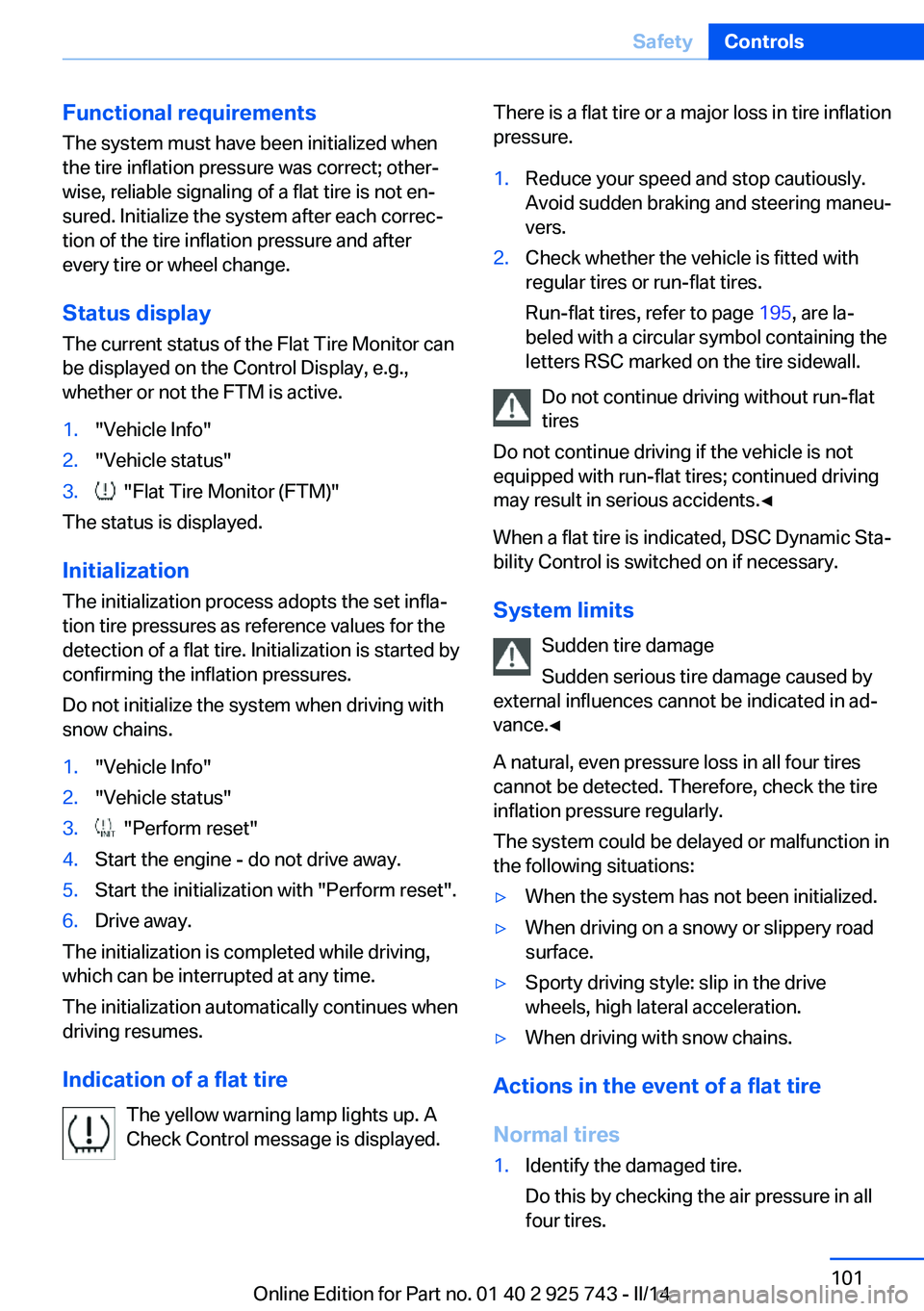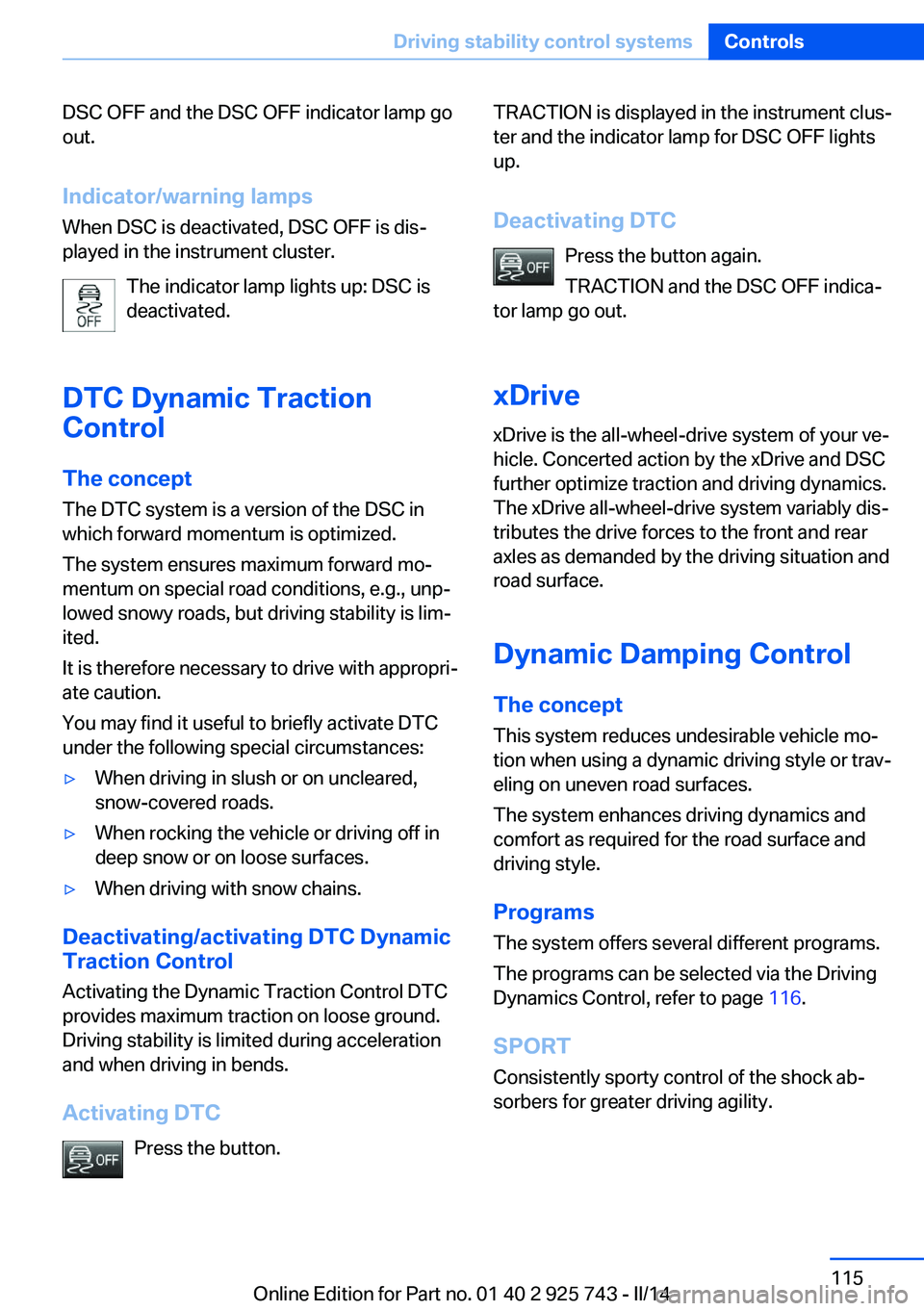2014 BMW 328I XDRIVE snow chains
[x] Cancel search: snow chainsPage 101 of 242

Functional requirements
The system must have been initialized when
the tire inflation pressure was correct; other‐
wise, reliable signaling of a flat tire is not en‐
sured. Initialize the system after each correc‐
tion of the tire inflation pressure and after
every tire or wheel change.
Status display The current status of the Flat Tire Monitor can
be displayed on the Control Display, e.g.,
whether or not the FTM is active.1."Vehicle Info"2."Vehicle status"3. "Flat Tire Monitor (FTM)"
The status is displayed.
Initialization
The initialization process adopts the set infla‐
tion tire pressures as reference values for the
detection of a flat tire. Initialization is started by
confirming the inflation pressures.
Do not initialize the system when driving with
snow chains.
1."Vehicle Info"2."Vehicle status"3. "Perform reset"4.Start the engine - do not drive away.5.Start the initialization with "Perform reset".6.Drive away.
The initialization is completed while driving,
which can be interrupted at any time.
The initialization automatically continues when
driving resumes.
Indication of a flat tire The yellow warning lamp lights up. A
Check Control message is displayed.
There is a flat tire or a major loss in tire inflation
pressure.1.Reduce your speed and stop cautiously.
Avoid sudden braking and steering maneu‐
vers.2.Check whether the vehicle is fitted with
regular tires or run-flat tires.
Run-flat tires, refer to page 195, are la‐
beled with a circular symbol containing the
letters RSC marked on the tire sidewall.
Do not continue driving without run-flat
tires
Do not continue driving if the vehicle is not
equipped with run-flat tires; continued driving
may result in serious accidents.◀
When a flat tire is indicated, DSC Dynamic Sta‐
bility Control is switched on if necessary.
System limits Sudden tire damage
Sudden serious tire damage caused by
external influences cannot be indicated in ad‐
vance.◀
A natural, even pressure loss in all four tires
cannot be detected. Therefore, check the tire
inflation pressure regularly.
The system could be delayed or malfunction in
the following situations:
▷When the system has not been initialized.▷When driving on a snowy or slippery road
surface.▷Sporty driving style: slip in the drive
wheels, high lateral acceleration.▷When driving with snow chains.
Actions in the event of a flat tire
Normal tires
1.Identify the damaged tire.
Do this by checking the air pressure in all
four tires.Seite 101SafetyControls101
Online Edition for Part no. 01 40 2 925 743 - II/14
Page 115 of 242

DSC OFF and the DSC OFF indicator lamp go
out.
Indicator/warning lamps When DSC is deactivated, DSC OFF is dis‐
played in the instrument cluster.
The indicator lamp lights up: DSC is
deactivated.
DTC Dynamic Traction
Control
The concept The DTC system is a version of the DSC in
which forward momentum is optimized.
The system ensures maximum forward mo‐
mentum on special road conditions, e.g., unp‐
lowed snowy roads, but driving stability is lim‐
ited.
It is therefore necessary to drive with appropri‐
ate caution.
You may find it useful to briefly activate DTC
under the following special circumstances:▷When driving in slush or on uncleared,
snow-covered roads.▷When rocking the vehicle or driving off in
deep snow or on loose surfaces.▷When driving with snow chains.
Deactivating/activating DTC Dynamic
Traction Control
Activating the Dynamic Traction Control DTC
provides maximum traction on loose ground.
Driving stability is limited during acceleration
and when driving in bends.
Activating DTC Press the button.
TRACTION is displayed in the instrument clus‐
ter and the indicator lamp for DSC OFF lights
up.
Deactivating DTC Press the button again.
TRACTION and the DSC OFF indica‐
tor lamp go out.
xDrive xDrive is the all-wheel-drive system of your ve‐
hicle. Concerted action by the xDrive and DSC
further optimize traction and driving dynamics.
The xDrive all-wheel-drive system variably dis‐
tributes the drive forces to the front and rear
axles as demanded by the driving situation and
road surface.
Dynamic Damping Control
The concept This system reduces undesirable vehicle mo‐tion when using a dynamic driving style or trav‐
eling on uneven road surfaces.
The system enhances driving dynamics and
comfort as required for the road surface and
driving style.
Programs The system offers several different programs.
The programs can be selected via the Driving
Dynamics Control, refer to page 116.
SPORT Consistently sporty control of the shock ab‐
sorbers for greater driving agility.Seite 115Driving stability control systemsControls115
Online Edition for Part no. 01 40 2 925 743 - II/14
Page 195 of 242

Rotating wheels between axlesDifferent wear patterns can occur on the frontand rear axles depending on individual driving
conditions. The tires can be rotated between
the axles to achieve even wear. Your service
center will be glad to advise you. After rotating,
check the tire pressure and correct if neces‐
sary.
Rotating the tires is not permissible on vehi‐
cles with different tire sizes on the front and
rear axles, i.e. when using different types of
tires.
Storage
Store wheels and tires in a cool, dry place with
as little exposure to light as possible.
Always protect tires against all contact with oil,
grease and fuels.
Do not exceed the maximum tire inflation pres‐
sure indicated on the side wall of the tire.
Run-flat tires
Label
RSC label on the tire sidewall.
The wheels are composed of special rims and
tires that are self-supporting, to a limited de‐
gree.
The support of the sidewall allows the tire to
remain drivable to a restricted degree in the
event of a pressure loss.
FTM: continued driving with a damaged tire,
refer to page 102.
TPM: continued driving with a damaged tire,
refer to page 99.
Changing run-flat tires
For your own safety, only use run-flat tires. No
spare tire is available in the case of a flat tire.
Your service center will be glad to advise you.
Snow chains
Fine-link snow chains
Only certain types of fine-link snow chains
have been tested by the manufacturer of the
vehicle, classified as road-safe and approved.
Information about the approved snow chains
are available from the service center.
Use
Use only in pairs on the rear wheels, equipped
with the tires of the following size:▷205/60 R 16.▷225/55 R 16.▷225/50 R 17.▷225/45 R 18.
Follow the chain manufacturer's instructions.
Make sure that the snow chains are always
sufficiently tight. Retighten as needed accord‐
ing to the chain manufacturer's instructions.
Do not initialize the Flat Tire Monitor after
mounting snow chains, as doing so may result
in incorrect readings.
Do not initialize the Tire Pressure Monitor after
mounting snow chains, as doing so may result
in incorrect readings.
When driving with snow chains, briefly activate
Dynamic Traction Control if necessary.
Maximum speed with snow chains Do not exceed a speed of 30 mph/50 km/h
when using snow chains.
Seite 195Wheels and tiresMobility195
Online Edition for Part no. 01 40 2 925 743 - II/14
Page 239 of 242

Shifting, automatic transmis‐sion 69
Shifting, manual transmis‐ sion 69
Shift paddles on steering wheel 71
Side airbags 94
Side View 133
Signaling, horn 12
Signals when unlocking 41
Sitting safely 47
Size 228
Slide/tilt glass roof 45
Smallest turning circle 228
Snow chains 195
Socket 152
Socket, OBD Onboard Diag‐ nostics 202
Soot particulate filter 163
SOS button 215
Spare fuse 213
Specified engine oil types 200
Speed, average 84
Speed limit detection, on‐ board computer 85
Speed limiter, display 81
Speed Limit Information 81
Speed warning 85
Split screen 22
SPORT+ - program, Dynamic Driving Control 116
Sport automatic transmis‐ sion 71
Sport displays, torque dis‐ play, performance dis‐
play 85
SPORT program, Dynamic Driving Control 117
Sport program, transmis‐ sion 71
Sport steering, variable 116
Stability control systems 114
Start/stop, automatic func‐ tion 63
Start/Stop button 61 Start function during malfunc‐
tion 33
Starting the engine 62
Status control display, tires 97
Status information, iDrive 21
Status of Owner's Manual 6
Steering wheel, adjusting 56
Steering wheel heating 56
Steptronic, automatic trans‐ mission 69
Stopping the engine 62
Storage compartment in the rear 158
Storage compartments 156
Storage compartments, loca‐ tions 156
Storage, tires 195
Storing the vehicle 224
Summer tires, tread 193
Supplementary text mes‐ sage 77
Surround View 130
Switch for Dynamic Driv‐ ing 116
Switch-on times, parked-car ventilation 147
Switch, refer to Cockpit 12
Symbols 6
Symbols in the status field 21
T Tachometer 78
Tail lamp 210
Tail lamps 210, 212
Technical changes, refer to Safety 7
Technical data 228
Telephone, see user's manual for Navigation, Entertain‐
ment and Communication
Temperature, automatic cli‐ mate control 142, 144
Temperature display for ex‐ ternal temperature 79 Temperature, engine oil 78
Tempomat, refer to Active Cruise Control 119
Terminal, starting aid 217
Text message, supplemen‐ tary 77
Theft alarm system, refer to Alarm system 41
Thigh support 49
Through-loading system 154
Tilt alarm sensor 42
Time of arrival 85
Tire damage 193
Tire identification marks 191
Tire inflation pressure 185
Tire inflation pressure moni‐ tor, refer to FTM 100
Tire Pressure Monitor TPM 97
Tires, changing 193
Tires, everything on wheels and tires 185
Tires, run-flat tires 195
Tire tread 193
Tone, see user's manual for Navigation, Entertainment
and Communication
Tool 204
Top View 134
Total vehicle weight 228
Touchpad 19
Tow fitting 219
Towing 218
Tow-starting 218
Tow truck 218
TPM Tire Pressure Moni‐ tor 97
Traction control 115
TRACTION program, Dy‐ namic Driving Control 115
Transmission, automatic 69
Transmission, manual 69
Transporting children safely 57
Tread, tires 193
Trip computer 85 Seite 239Everything from A to ZReference239
Online Edition for Part no. 01 40 2 925 743 - II/14